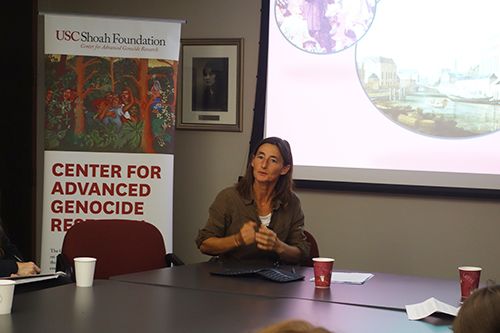Center Fellow Geraldien von Frijtag Sheds Light on Jews and Gentiles in the Netherlands

But Geraldien von Frijtag Drabbe Kunzel (Utrecht University, the Netherlands) discovered that the Frank family’s experience is rare among the Jews of the Netherlands and questioned commonly-held perceptions about relations between Dutch Jews and gentiles during the Holocaust during her tenure as USC Shoah Foundation Center for Advanced Genocide Research’s 2017-2018 Center Fellow. She gave a public lecture about her research in the Visual History Archive over the past three months on the USC campus on November 9.
von Frijtag began her lecture by sharing some important characteristics of Dutch culture and society. The country is very organized, she said, with highly structured government and laws, and yet is also socially permissive.
The Netherlands had a long history before World War II of welcoming Jewish refugees, integrating them into society and allowing them to practice their own religion, she said, which has led to a “myth of tolerance” among Dutch people.
“We have a long tradition, we think, of being tolerant of minorities,” she said.
This assumption is what von Frijtag wanted to probe by watching testimonies of Dutch Jewish Holocaust survivors in the Visual History Archive during her fellowship.
She pointed out that basic data dispels at least part of the myth that Jews were protected at a higher rate in the Netherlands than in other countries in Europe. In 1940, there were 140,000 Jews in the Netherlands and by 1945, only 35,000 were registered there – a decrease of 75 percent.
“On one hand you have this myth of tolerance, and on the other hand you have the facts,” she said. “Something must have happened in the Netherlands during the war for this to happen.”
To find out, von Frijtag turned to the Visual History Archive. She watched 180 testimonies of Dutch survivors, paying particular attention to how they identified themselves, their communities, and their interactions with gentiles before the war, and how this changed during and after the war.
She found that before the war, those who defined themselves as Jewish were more likely to interact within a mostly Jewish community, go to Jewish schools, and live in a smaller town. On the opposite end of the spectrum were survivors who went to non-Jewish schools, had almost exclusively gentile friends and may not have even known they were Jewish. These nonreligious Jews were also more likely to live in the city.
There were also intergenerational differences, von Frijtag discovered. Survivors who were children at the time often described themselves as interacting with a diverse group of friends but they knew their parents’ social circle was mainly Jewish.
In general, very few survivors remembered acts of antisemitism before the war, and they were friendly with their gentile neighbors and coworkers.
However, almost immediately after the Netherlands was occupied by Nazi Germany in May 1940, “the community starts to fall apart,” von Frijtag said. “People that were friends were more and more out of the picture.”
As a result of German policies restricting where Jews could live, Jews were forced to move to certain areas of Amsterdam, and they were not allowed to work or go to school. In their testimonies, survivors recall feeling great sadness and disappointment when former friends stopped speaking to them – though some also remember their gentile classmates mourning with them when they were forced to leave school. It was during this time that some discovered, for the first time, that they were even Jewish in the first place.
Once Jewish persecution and deportations were fully in effect, von Frijtag noted that unlike the Frank family, most families were split up. People trying to evade arrest had to move from hiding place to hiding place almost constantly and had very little control over their living conditions, as those who agreed to hide them often did so for their own personal gain, not necessarily pure altruism. Some survivors acted as free labor for their rescuers and others had to pay them.
But von Frijtag also acknowledged the creativity and strength Dutch Jews displayed during the Holocaust in order to save themselves and their families. The testimonies illustrate the fortitude that survivors needed in order to find hiding places and evade capture.
Based on her research, von Frijtag came to the preliminary conclusion that the “myth of tolerance” is not necessarily a myth – Dutch society was remarkably tolerant toward Jews in spite of influence from Germany – but it may need to be modified in order to accurately represent what Dutch Jews went through.
“Testimony makes it clear that the myth of tolerance does not have to be rejected,” von Frijtag said. “But we need to look at how we define tolerance. We may have to rethink it a little differently.”